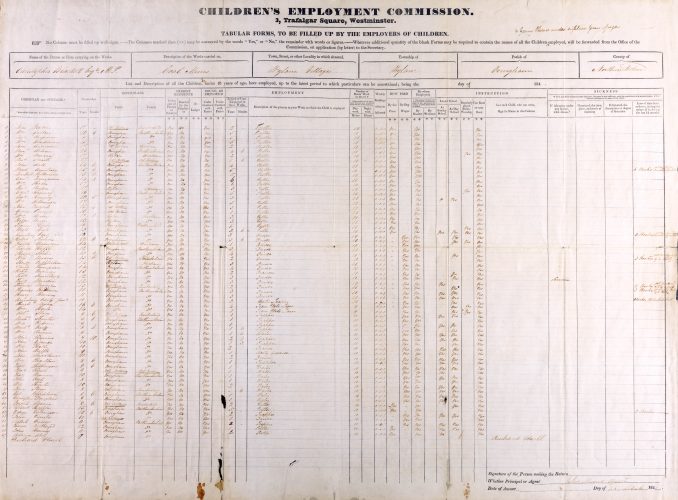Children’s employment commission:
return of children and young people, Wylam Colliery, 1841
Reference: ZKB/A/27/1
Suggested age groups: KS3, KS4, Lifelong Learners
Subject areas: History, Literacy, Maths, Art
CONTEXT
In 1840 Parliament set up the Children’s Employment Commission. The aim of the Commission was to investigate the working conditions of children under the age of 18, who were employed in coal mines, lead mines and iron works.
The Commission was set up by Lord Ashley, Earl of Shaftesbury. He also campaigned for improved conditions and education for children working in factories and for the banning of chimney sweeps.
Each colliery had to fill in a form like this and send the information to the Commission. The form included names, ages and birthplaces of the children employed at the colliery as well as details of employment, literacy levels, salary and sickness record.
The return for Wylam Colliery is the only one to have survived locally.
ACTIVITIES
ACTIVITY 1
Background
In 1840 Parliament set up the Children’s Employment Commission. The aim of the Commission was to investigate the working conditions of children under the age of 18, who were employed in coal mines, lead mines and iron works.
The Commission was set up by Lord Ashley, Earl of Shaftesbury. He also campaigned for improved conditions and education for children working in factories and for the banning of chimney sweeps.
SEE
See: When did Parliament set up the Children’s Employment Commission?
See: What was the aim of the Children’s Employment Commission?
See: What did the Children’s Employment Commission investigate?
See: Who set up the Commission?
See: What did Lord Ashley, Earl of Shaftsbury campaign for?
THINK
Think: Why was the Children’s Employment Commission set up?
Think: Why did children under 18 work in mines and iron works?
Think: What types of jobs did the children do in mines and iron works?
Think: What types of conditions did the children work in?
Think: What types of backgrounds do you think the children who worked in mines and iron works came from?
Think: How well educated do you think the children who worked in mines and iron works were?
DO
Do: How effective was the Children’s Employment Commission? Create a presentation showing the short- and long-term outcomes of the work done by the Children’s Employment Commission.
Do: Using the information on the return, make a list of the types of reform you think were needed in mines.
Do: Select one item from your list and create a plan to campaign for reform in that area.
Do: Host a debate where you argue for reform in your chosen area against someone opposing reform. Consider who might have opposed reform and why.
Do: Research child labour laws in Britain today. Create a Venn diagram showing the differences and similarities between Victorian child labour and present-day child labour.
Do: Make a list of any areas in present-day child labour laws that you think should be reformed. Write a letter to your local MP about your concerns and make suggestions for how they could be reformed.
Resources
ACTIVITY 2
Background
Each colliery had to fill in a form like this and send the information to the Commission. The form included names, ages and birthplaces of the children employed at the colliery as well as details of employment, literacy levels, salary and sickness record.
The return for Wylam Colliery is the only one to have survived locally.
SEE
See: Who had to fill in Children’s Employment Commission return forms?
See: What types of information did the return include?
See: How many children under the age of 18 were recorded as working at Wylam Colliery on the return?
See: What is the age of the youngest worker recorded on the return?
See: What types of work does the return say the children did?
See: How many hours did the children work each day?
See: How many of the children attended school?
See: How many of the children could read?
See: What is the highest amount of money the children earned each week?
See: What is the lowest amount of money the children earned each week?
THINK
Think: What units of currency were used in the Victorian times?
Think: Are you surprised by how many of the children attended school and could read?
Think: How accurate do you think the data is on the return? Using what you have learned about working children, do you think the number of children listed as attending school and able to read is likely to be truthful?
Think: Why might the return have been filled in using incorrect data?
Think: Why do you think this return is the only one of its kind to have survived locally?
Think: How useful do you think the return was for the Commission?
DO
Do: Using the National Archives currency convertor, work out how much the children’s lowest and highest weekly income would have been today’s money. Do you think the children were paid fairly?
Do: Read some of the testimonies gathered by the Commission. Make a list of the words that the children use to describe their work, the mine environment and how they felt about it. Do you think they enjoyed working?
Do: Using the descriptions, testimonies and images in the Commission’s 1842 report, create an artwork showing a scene that one of the children may have been part of on a day to day basis.
Resources
OTHER ONLINE RESOURCES
British Library article on Children’s Employment Commission (includes scans of some of the pages including illustrations):
https://www.bl.uk/collection-items/report-on-child-labour-1842
The Victorian Web site, page with testimonies printed in report of Children’s Employment Commission:
http://www.victorianweb.org/history/ashley.html
Spartacus Educational website, page for Lord Ashley, Earl of Shaftesbury: https://spartacus-educational.com/IRashley.htm
Spartacus Educational website, page for coal mining 1600-1925, includes sub-section on Children’s Employment Commission:
https://spartacus-educational.com/CoalIndustry.htm#section5
Newcastle University Library education and outreach website, page on children mine workers:
https://www.ncl.ac.uk/webtemplate/libraryassets/external/education-outreach-mining/
Durham Mining Museum website, page for mining terminology: http://www.dmm.org.uk/books/terms.htm


